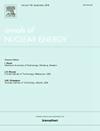Preliminary studies on diversion and misuse for TRISO-fueled heat-pipe-cooled microreactors
IF 1.9
3区 工程技术
Q1 NUCLEAR SCIENCE & TECHNOLOGY
引用次数: 0
Abstract
Microreactors are being developed by multiple reactor designers to mass-produce nuclear facilities for worldwide deployment. Including microreactors in a country’s energy portfolio introduces new concerns for international safeguards regarding the number of reactor locations. Microreactors have smaller quantities of nuclear material compared to current light-water reactors, which makes diverting enough material for clandestine purposes difficult for a single reactor. Diversion or misuse of multiple microreactors to obtain a significant quantity introduces a new acquisition pathway. This work examines diversion and misuse scenarios for a realistic heat-pipe-cooled microreactor to understand how these scenarios would effect reactor operations to determine if monitoring key parameters could reduce the burden of inspection on monitoring agencies. We determined misuse caused too drastic of an effect on core operations to be a valid acquisition pathway for the realistic heat-pipe-cooled microreactor. Diversion was explored across varying levels of severity, where potential diversion scenarios could yield one significant quantity of material from between six and eleven microreactors. Through examining the critical control drum angle, excess reactivity, control drum worth, and power distribution changes from nominal were detected over the operational lifetime, which could indicate a divergence from normal operations.
求助全文
约1分钟内获得全文
求助全文
来源期刊

Annals of Nuclear Energy
工程技术-核科学技术
CiteScore
4.30
自引率
21.10%
发文量
632
审稿时长
7.3 months
期刊介绍:
Annals of Nuclear Energy provides an international medium for the communication of original research, ideas and developments in all areas of the field of nuclear energy science and technology. Its scope embraces nuclear fuel reserves, fuel cycles and cost, materials, processing, system and component technology (fission only), design and optimization, direct conversion of nuclear energy sources, environmental control, reactor physics, heat transfer and fluid dynamics, structural analysis, fuel management, future developments, nuclear fuel and safety, nuclear aerosol, neutron physics, computer technology (both software and hardware), risk assessment, radioactive waste disposal and reactor thermal hydraulics. Papers submitted to Annals need to demonstrate a clear link to nuclear power generation/nuclear engineering. Papers which deal with pure nuclear physics, pure health physics, imaging, or attenuation and shielding properties of concretes and various geological materials are not within the scope of the journal. Also, papers that deal with policy or economics are not within the scope of the journal.
 求助内容:
求助内容: 应助结果提醒方式:
应助结果提醒方式:


